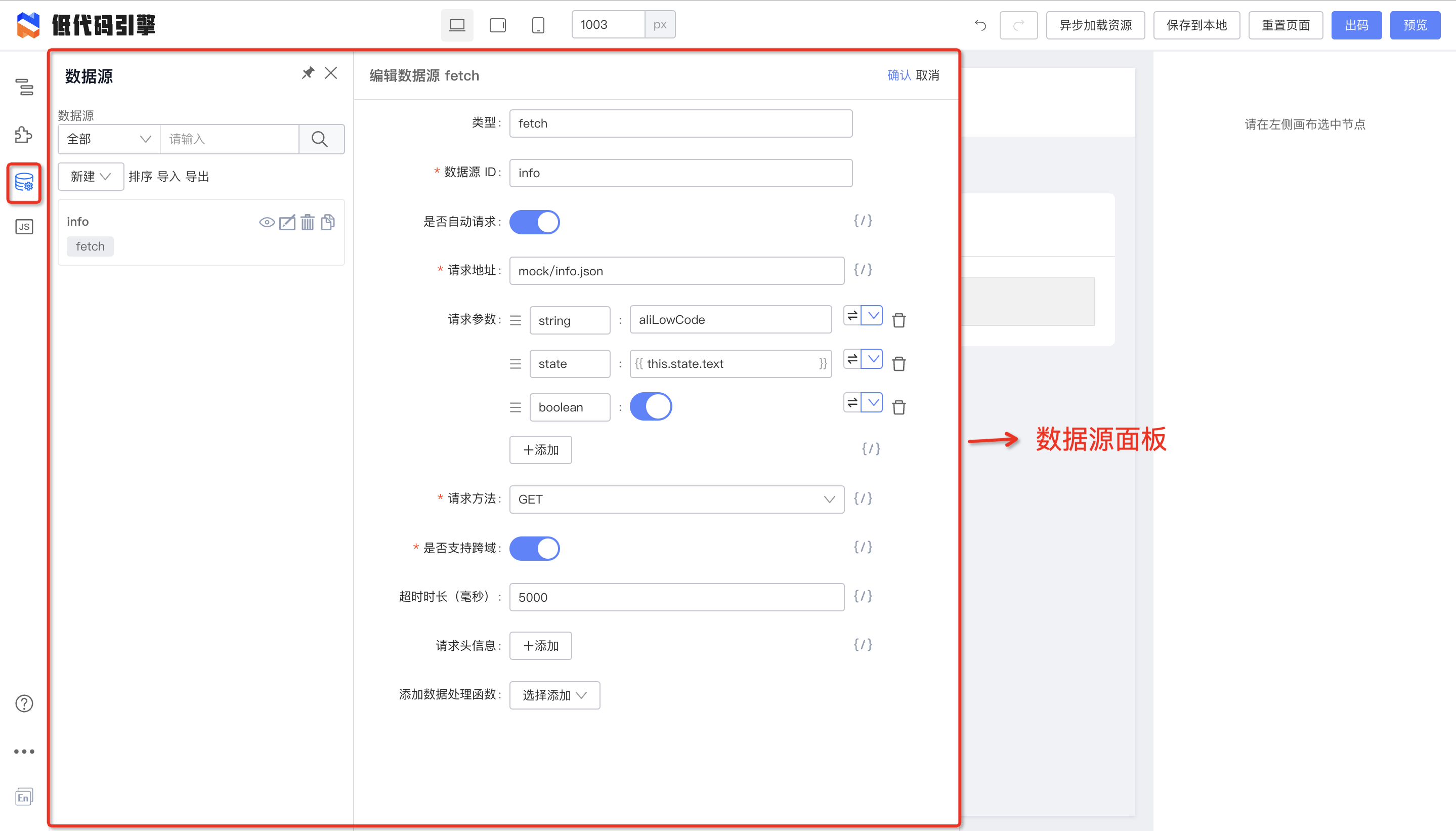8. 数据源面板详解
🪚 概述
数据源面板主要负责管理低代码中远程数据源内容,通过可视化编辑的方式操作低代码协议中的数据源 Schema,配合 数据源引擎 即可实现低代码中数据源的生产和消费;

数据源面板
❓如何使用
面板内包含了数据源创建、删除、编辑、排序、导入导出、复制以及搜索等能力,内置支持了
fecth&JSONP两种常用远程请求类型;
三步创建一个数据源
 三步创建数据源
三步创建数据源
参数详解
TODO
☠️ 更多介绍
数据源顺序
数据源为何支持排序功能,主要原因是数据源的加载存在先后顺序;接下来我们从协议层以及实现层看数据源之间的顺序关系;
TODO
如何定制数据源
定制数据源类型(设计态)
定制数据源请求实现(运行态)
当出现以下两种情况的时,我们需要定制数据源请求实现,
- 当你默认提供的
handler无法满足你的需求- 定制了数据源类型,比如
GraphQL,需要实现一个对应的handler
接下来我们来看一个例子,如何实现一个 handler
import { RuntimeOptionsConfig } from '@alilc/lowcode-datasource-types';
import request from 'universal-request';
import { RequestOptions, AsObject } from 'universal-request/lib/types';
export function createFetchHandler(config?: Record<string, unknown>) {
return async function(options: RuntimeOptionsConfig) {
const requestConfig: RequestOptions = {
...options,
url: options.uri,
method: options.method as RequestOptions['method'],
data: options.params as AsObject,
headers: options.headers as AsObject,
...config,
};
const response = await request(requestConfig);
return response;
};
}
低代码 fetch-handler 默认实现
以上代码是低代码内置的 fetch-handler 默认实现,内部使用了 universal-request,假如你们内部使用的 axios,你完全重新实现一个;
import axios from 'axios';
export function createAxiosFetchHandler(config?: Record<string, unknown>) {
return async function(options: RuntimeOptionsConfig) {
const requestConfig: RequestOptions = {
...options,
url: options.uri,
method: options.method as RequestOptions['method'],
data: options.params,
headers: options.headers,
...config,
};
const response = await axios(requestConfig);
return response;
};
}
注册到 render
完成一个 Handler 后你可以通过以下方式接入到 render 或者出码中使用
渲染 Render
import React, { memo } from 'react';
import ReactRenderer from '@alilc/lowcode-react-renderer';
const SamplePreview = memo(() => {
return (
<ReactRenderer
className="lowcode-plugin-sample-preview-content"
schema={schema}
components={components}
appHelper={{
requestHandlersMap: {
fetch: createAxiosFetchHandler()
}
}}
/>
);
});
出码
目前自定义只能通过重新定义类型来完成,接下来我们会给出码添加 requestHandlersMap 映射能力;如有需求请联系 荣彬 (github-id:xingmolu)
设计态启用数据源引擎
默认情况下设计态没有开启数据源引擎,我们可以在设计器 init 的时候来传递
requstHandlersMap来开启;具体代码如下:
import { init, plugins } from '@alilc/lowcode-engine';
import { RequestHandlersMap } from '@alilc/lowcode-datasource-types';
const preference = new Map();
(async function main() {
await plugins.register(scenarioSwitcher);
await registerPlugins();
init(document.getElementById('lce-container')!, {
// designMode: 'live',
// locale: 'zh-CN',
enableCondition: true,
enableCanvasLock: true,
// 默认绑定变量
supportVariableGlobally: true,
// simulatorUrl 在当 engine-core.js 同一个父路径下时是不需要配置的!!!
// 这里因为用的是 alifd cdn,在不同 npm 包,engine-core.js 和 react-simulator-renderer.js 是不同路径
simulatorUrl: [
'https://alifd.alicdn.com/npm/@alilc/lowcode-react-simulator-renderer@latest/dist/css/react-simulator-renderer.css',
'https://alifd.alicdn.com/npm/@alilc/lowcode-react-simulator-renderer@latest/dist/js/react-simulator-renderer.js'
],
requestHandlersMap: {
fetch: createAxiosFetchHandler()
}
}, preference);
})();
🥡 附录
数据源协议
| 参数 | 说明 | 类型 | 支持变量 | 默认值 | 备注 |
|---|---|---|---|---|---|
| id | 数据请求 ID 标识 | String | - | - | |
| isInit | 是否为初始数据 | Boolean | ✅ | true | 值为 true 时,将在组件初始化渲染时自动发送当前数据请求 |
| isSync | 是否需要串行执行 | Boolean | ✅ | false | 值为 true 时,当前请求将被串行执行 |
| type | 数据请求类型 | String | - | fetch | 支持四种类型:fetch/mtop/jsonp/custom |
| shouldFetch | 本次请求是否可以正常请求 | (options: ComponentDataSourceItemOptions) => boolean | - | () => true | function 参数参考 ComponentDataSourceItemOptions 对象描述 |
| willFetch | 单个数据结果请求参数处理函数 | Function | - | options => options | 只接受一个参数(options),返回值作为请求的 options,当处理异常时,使用原 options。也可以返回一个 Promise,resolve 的值作为请求的 options,reject 时,使用原 options |
| requestHandler | 自定义扩展的外部请求处理器 | Function | - | - | 仅 type=‘custom’时生效 |
| dataHandler | request 成功后的回调函数 | Function | - | response => response.data | 参数:请求成功后 promise 的 value 值 |
| errorHandler | request 失败后的回调函数 | Function | - | - | 参数:请求出错 promise 的 error 内容 |
| options {} | 请求参数 | ComponentDataSourceItemOptions | - | - | 每种请求类型对应不同参数,详见见 ComponentDataSourceItemOptions 对象描述 |